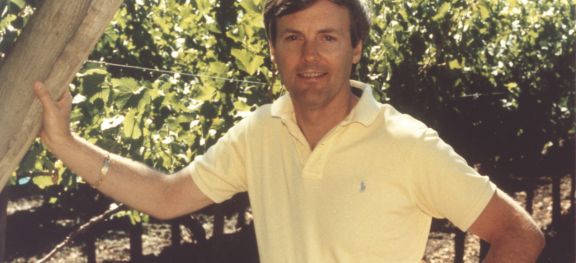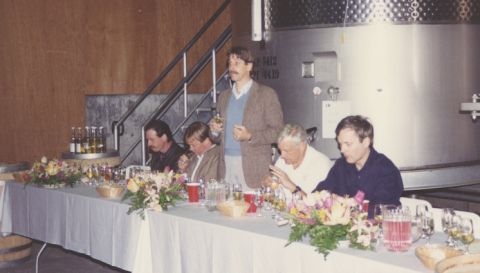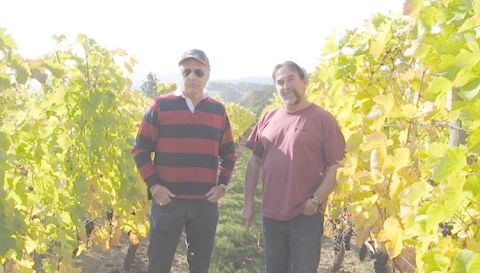Tom Selfridge – eminence grise


Brian Croser, veteran Australian wine producer, profiles an important, if unsung, contributor to California wine, seen above in the 1990s when he was Jess Jackson's right-hand man.
At the age of 80, Tom Selfridge is just stepping away from the last of his many consultancies, taken on after a remarkable number and variety of leadership roles in California wine. What makes him unique is that he not only employed top-quality commercial, financial and economic professionalism, but did it governed by the principles of high-quality winemaking. This when corporate takeovers in the wine industry were introducing FMCG (fast-moving consumer goods) people with no feeling for the ethos and technology of wine quality. Because of this he won the respect of the California wine community, saved businesses for his employers, and has been such a role model that of his contemporaries he has been the last man working.
It is not surprising that Selfridge should have such a good business head. He is very private about his family origins but grew up in the affluent small town of Ross in Marin County at the northern end of the Golden Gate Bridge and is part of the informal aristocracy of the Bay Area, his great-grandfather having started the now giant Del Monte food corporation whose original 1907 factory is now celebrated as The Cannery at Fisherman’s Wharf in San Francisco.
After an undergraduate degree in economics from Berkeley and an MA in economics from San Francisco State, he chose to do a PhD in economics at the Wharton School of the University of Pennsylvania, where he discovered his heart wasn’t in theoretical economics. Working for Del Monte proved no more stimulating so he decided to escape the corporate cage to become the maker of something rather than a counter or canner of everything.
Growing up in the Bay Area in the 1960s, he was surrounded by the emerging fine-wine industry of Napa and Sonoma. Twiddling his thumbs at his desk at Del Monte, Selfridge had a lightbulb moment and applied for the Master’s programme in Viticulture and Enology in the Department of Food Science at UC Davis. Winemaking would provide the combination of science and arts that Tom craved and which had not been delivered by economics.
I met him in 1972 in the first viticulture class of the year. In a country where life stories are told to strangers in an instant, Selfridge was unusually reserved and measured in our class of extroverts. He became my classmate friend of choice and 50 years later I am still discovering things about him.
Over the years he was to become president of Beaulieu Vineyards, the late Jess Jackon’s right-hand man at Kendall-Jackson, president and CEO of the Chalone Wine Group, president of The Hess Collection winery and a long-term board member of J Lohr as well as technical and financial consultant to many other fine-wine businesses. His career is worth studying.
In 1972 and 1973, as we both studied at Davis, Selfridge and his wife Robin were our expert guides to the joys of the Bay Area. While I lived with my wife Ann on campus in the married-student housing of Orchard Park, Tom and Robin lived in Tiburon on San Francsico Bay, an hour and a half drive to and from Davis.
A highlight of our times together was New Year’s Eve 1973 at Ondine, a restaurant on a wharf in Sausalito, the roasted pheasant accompanied by my first experience of Chambertin. Memorably, we walked across the Golden Gate Bridge together the next day.
We established a strong friendship with our professors, and in particular the legendary Maynard Amerine. Tom and I invited him to lunch in our humble flat in Orchard Park. I think we ate sandwiches and drank Hardys McLaren Vale Shiraz. Amerine was quite emotional because, he said, in 38 years of teaching it was the first time students had invited him to a meal. He reciprocated by asking Tom and me to his exclusive mens’ club in Sacramento.
In 1980 Amerine gave the opening speech at the Centenary Symposium of the Department of Viticulture and Enology, formed at Berkeley initially and then transferred to Davis. His influence on us can be summarised in his description of the influence of the Viticulture and Enology Department on the California wine industry: ‘A case can be made that the University has had a greater impact on the philosophy than the technology of the California grape and wine industry. That philosophy is quality. Quality may be hard to define but when you have got it everyone can recognise it.’
Amerine created two disciples respectively in the California and Australian wine industries, each of us equally convinced of the paramount importance of quality.
In a typically well-planned way Selfridge had set his sights on the plum job of the California wine industry at the time. The most revered winery was Beaulieu Vineyards in Rutherford. In 1973 the legendary winemaker André Tschelistcheff was due to retire after 35 years in the job.
I watched Selfridge angle, against the odds, to get the job. He had the confidence and friendship of Tschelistcheff but the alcoholic-beverage distribution company, Heublein Corporation, that had taken over Beaulieu had installed executives who had other ideas. Selfridge, as he does, persevered. He took time off the Davis Master’s programme, against the wishes of the department, to work as a cellarhand at Beaulieu through the difficult 1972 vintage. As a result, after graduation in 1973 he was employed at Beaulieu as assistant winemaker and viticulturist.
In 1977 he was appointed Beaulieu winemaker and then, in a pattern to be repeated, he was elevated to vice president in 1980 and finally president in 1983, remaining in that role until 1990. Selfridge’s economic and management skills trumped his viticultural and winemaking ambitions. There were few if any wine-industry managers that possessed his unique combination of financial and technical expertise and time and again that would be recognised throughout his outstanding career.
In 1990 he was recruited by Jess Jackson, who needed to bring some administrative order to his burgeoning wine empire. Tom and Jess teamed well, not an easy thing to accomplish. As senior vice president, production, marketing and administration, Selfridge oversaw a sixfold increase in production and brought administrative order to the Kendall-Jackson wine company. Thanks to Jackson’s restlessness, this was probably the most exhausting of any of Selfridge’s roles and he left in 1997, again answering a call, this time to head up the first publicly traded fine-wine corporation, the Chalone Wine Group.
The Chalone Wine Group had been founded by pioneering winemaker Richard Graff and corporate management visionary Philip Woodward in 1984. Richard Graff would be killed in a light-aircraft crash, just after welcoming Tom as the new CEO of Chalone in 1997.
In a recurring coincidence of our paths, Tom was joining the company that had served as the model for my taking my wine company Petaluma public in Australia in 1992. Phil Woodward’s vision for Chalone was to acquire complementary small fine-wine businesses in different California regions and protect their brand and production autonomy under a publicly traded parent entity. That was exactly the vision I successfully adopted for Petaluma in Australia through the 1990s.
Tom inherited a Chalone Wine Group of seven wineries including Acacia in Carneros, Edna Valley in the Central Coast and Canoe Ridge in Washington State. During his tenure at Chalone he reorganised each of the existing brands to reflect the premium vision of the company and established five more complementary California regional brands.
However, his biggest challenge at Chalone was not technical, financial or marketing. It was managing the public shareholder register. In 1989, by mutual agreement, Chalone added Domaines Barons de Rothschild (DBR), headed by Baron Eric de Rothschild, to its share register in exchange for the provision of extra capital with which Chalone could make further acquisitions. The two companies were also entwined in a successful distribution arrangement.
Again, perhaps not by coincidence given the acuity of DBR, they were initial shareholders in the public float of Petaluma in 1992, although they sold at a good profit well before the much more lucrative 2002 takeover of Petaluma by Lion Nathan.
Then Selfridge faced a difficult shareholder situation at Chalone. In 2004 DBR, the major shareholder, organised a $9.25-per-share offer to all other shareholders to take Chalone private. Tom knew this seriously undervalued the company and he fought to open up the share register for competitive bids and obtain maximum shareholder value, earning the considerable displeasure of DBR. In early 2005 the giant drinks corporation Diageo acquired the Chalone Wine Group for $14.25 a share, a more-than-50% premium on DBR’s initial offer. With the takeover Tom’s role at Chalone was finished.
Another pleading phone call and another rescue mission, this time from the chairman of the Swiss-owned Hess Collection winery on Napa’s Mount Veeder. Hess was operating so poorly that when the owner, the late Donald Hess, first spoke to Selfridge from Switzerland, he asked, ‘Do you think there is anything worth saving here?’
Despite a fractious relationship with Hess, Selfiridge went about what he does best, rejuvenating the wonderful Mount Veeder vineyards, renovating the winery, elevating wine quality and prices, and refreshing the brands, thereby answering in the affirmative Hess’s original question.
After leaving Hess in 2009, Selfridge served on the board of wine producer J Lohr until 2019 and retained a number of private consultancies. In October of 2023 Selfridge voluntarily retired from the last of those, but he will no doubt continue to think on the many unanswered questions that make the business of fine wine worth a lifetime of endeavour while providing endless fascination.
Few have made such profound contributions to the health of the California fine-wine business while remaining largely hidden from public gaze than my friend Tom Selfridge.
Become a member to view this article and thousands more!
- 15,406 featured articles
- 274,946 wine reviews
- Maps from The World Atlas of Wine, 8th edition (RRP £50)
- The Oxford Companion to Wine, 5th edition (RRP £50)
- Members’ forum
- 15,406 featured articles
- 274,946 wine reviews
- Maps from The World Atlas of Wine, 8th edition (RRP £50)
- The Oxford Companion to Wine, 5th edition (RRP £50)
- Members’ forum
- Commercial use of our Tasting Notes

